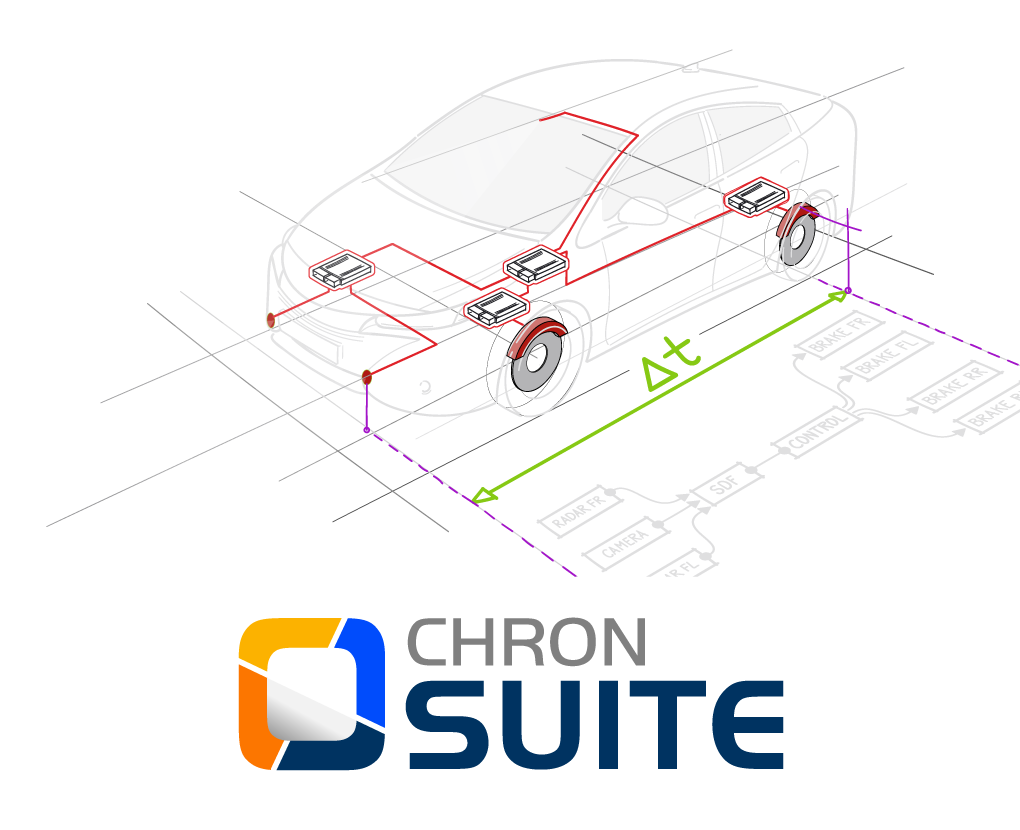chronSUITE
Feature Overview
chronSUITE, comprising of chronSIM, chronVIEW, and chronVAL, provides a rich array of tools for analyzing timing-relevant use cases of embedded systems.
Learn more about all the latest features below.
Modeling of Heterogeneous SoC Hardware Architectures
2.9
3.0
Multicore processors and hardware accelerators
Modeling of Software Components
2.9
3.0
Simple component model that encapsulates data and functions
Support for multiple levels of abstraction to model the internal behavior of functions such as a probability distributions and C / C++ code
Modeling of process and function call graphs
Modeling the Execution Behavior of Processes and Functions
2.9
3.0
Best-case, worst-case execution time and probability distributions
Definition of modes and mode-dependent execution branches
Call graph primitives for inter-process communication such as events, semaphores, and spinlocks
Definition of counters and operators for manipulating counters
Modeling of explicit and rate-based data accesses
Support of C / C++ as a modeling language for execution behavior
Modeling of Queued Communication and Event Chains
2.9
3.0
Modeling of communication links as queues with different access policies
Dedicated call graph items to accurately model the timing of communication within the control flow.
Modeling of the routing of signals between inputs and outputs within a call graph
Communication modeling dependent on system status and controlled through mode variable queries; required for data flow simulation in ADAS and AD systems.
Strict separation of a data flow specification and its observation in the trace
Uniform evaluation of measured and simulated traces
Graphical model editor for event chains
Modeling of Buses and Networks
2.9
3.0
Simulation of LIN, CAN-FD, FlexRay, and Ethernet network peripherals
C / C++ API for simulation
Scheduling Simulation
2.9
3.0
Prediction of scheduling effects and timing violations
Simulation of time synchronization and drifting clocks in distributed systems
Simulation of multithreaded applications
Modeling of complex stimulation scenarios
Simulation of AUTOSAR / OSEK systems
chronVAL module for schedulability analysis and formal timing verification
Batch-mode simulation and interactive simulation control
C / C++ API for simulation of custom (user-defined) scheduling strategies
Verification of Requirements
2.9
3.0
Specification of timing and performance requirements in chronSIM
Compliance with ASAM ARTI standard
Specification of end-to-end event chains for ADAS and AD applications
Automated verification and generation of result reports
Extensive statistical analysis
Import of timing requirements
Optimization
2.9
3.0
chronOPT module for architecture optimization
Trace Analysis
2.9
3.0
Visualization of RTOS scheduling, function nesting, data and control flow, user-defined events and event sequences, data values and rates, stack consumption, etc.
Interactive trace view with customizable diagrams for analyzing events, process state changes, resource utilization, etc.
Histograms and box plots
Definition and automated verification of timing and performance requirements
Continuous traceability of requirements (e.g. for IBM DOORS)
Automated model generation for simulation and analysis
Results report in HTML format with customizable templates
Results report in CSV / Excel format
Batch / CLI mode for workflow automation
Trace Import
2.9
3.0
Import of both standard (e.g. ARTI, BTF, T1) and proprietary trace formats
Intelligent wizard with built-in error detection, indication, and correction
Full support of multicore and multi-CPU traces
Capable of handling very large traces
Trace merge assistance
Tool Integrations
2.9
3.0
Lauterbach, iSYSTEM, PLS, ETAS, Express Logic, Gliwa, GreenHills, Vector, Windriver
Python API for model generation
EMF Ecore model
Metrics server with REST API
Backward Compatibility
2.9
3.0
Migration of previous models and trace files
included
coming soon

